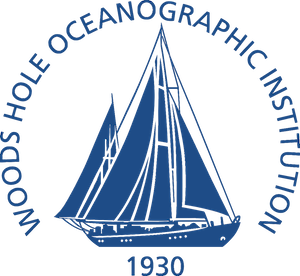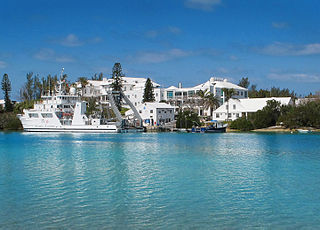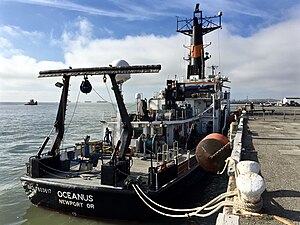
The Woods Hole Oceanographic Institution is a private, nonprofit research and higher education facility dedicated to the study of marine science and engineering.

A research vessel is a ship or boat designed, modified, or equipped to carry out research at sea. Research vessels carry out a number of roles. Some of these roles can be combined into a single vessel but others require a dedicated vessel. Due to the demanding nature of the work, research vessels may be constructed around an icebreaker hull, allowing them to operate in polar waters.

RV Atlantis is a Thomas G. Thompson-class oceanographic research ship, owned by the US Navy and operated by the Woods Hole Oceanographic Institution as part of the University-National Oceanographic Laboratory System (UNOLS) fleet. She is the host vessel of DSV Alvin. She is named for the first research vessel operated by WHOI, the sailboat RV Atlantis, for which the Space ShuttleAtlantis is also named.

RV Knorr was a research vessel formerly owned by the U.S. Navy and operated by the Woods Hole Oceanographic Institution for the U.S. research community in coordination with and as a part of the University-National Oceanographic Laboratory System (UNOLS) fleet. On March 14, 2016, Knorr was officially transferred to the Mexican Navy and renamed Rio Tecolutla. She was replaced at Woods Hole by the RV Neil Armstrong. Knorr is best known as the ship that supported researchers as they discovered the wreck of the RMS Titanic in 1985. R/V Knorr (AGOR-15) has traveled more than a million miles—the rough equivalent of two round trips to the Moon or forty trips around the Earth. Her sister ship is the RV Melville.

R/V Thomas G. Thompson (AGOR-23), an oceanographic research vessel and lead ship of her class, is owned by the United States Office of Naval Research and operated under a bareboat charterparty agreement by the University of Washington as part of the University-National Oceanographic Laboratory System (UNOLS) fleet.

Nereus was a hybrid uncrewed autonomous underwater vehicle built by the Woods Hole Oceanographic Institution (WHOI). Constructed as a research vehicle to operate at depths of up to 11,000 metres (36,000 ft), it was designed to explore Challenger Deep, the deepest surveyed point in the global ocean. Nereus, named for Greek sea titan Nereus through a nationwide contest of high school and college students, began its deep sea voyage to Challenger Deep in May 2009 and reached the bottom on May 31, 2009.

The Ocean Observatories Initiative (OOI) is a National Science Foundation (NSF) Major Research Facility composed of a network of science-driven ocean observing platforms and sensors in the Atlantic and Pacific Oceans. This networked infrastructure measures physical, chemical, geological, and biological variables from the seafloor to the sea surface and overlying atmosphere, providing an integrated data collection system on coastal, regional and global scales. OOI's goal is to deliver data and data products for a 25-year-plus time period, enabling a better understanding of ocean environments and critical ocean issues.

The Hatfield Marine Science Center(HMSC) is a marine science research and education center next to Yaquina Bay of the Pacific Ocean in the U.S. state of Oregon. It is operated by Oregon State University in cooperation with five state and federal agencies co-located on site. Named after Mark Hatfield, a former U.S. Senator from Oregon, the HMSC occupies a 49-acre (20 ha) site in Newport.
William B. Curry is an American oceanographer who is the president and CEO of the Bermuda Institute of Ocean Studies (BIOS). He is known for studying historical climate and ocean circulation. Curry holds a Bachelor of Science in geology from the University of Delaware (1974) and a PhD in geology from Brown University (1980).

Thomas G. Thompson (T-AGOR-9) was a Robert D. Conrad-class oceanographic research ship acquired by the U.S. Navy in 1965. The ship was transferred to the University of Washington for operation as part of the University-National Oceanographic Laboratory System (UNOLS) fleet on 21 September 1965. In 1988 the ship went out of UNOLS service. The ship, retaining the previous name, was designated by the Navy as IX-517 assigned to the Mare Island Naval Shipyard for general naval research. Thomas G. Thompson was later renamed Pacific Escort II with the same designation. On 7 May 1997 the Navy renamed the ship Gosport and transferred the ship to the Norfolk Naval Shipyard available for hire as a multi purpose platform from the shipyard. The ship, placed out of service and struck from the register on 27 February 2004, was sunk as part of a NATO exercise 14 November 2004.
RV Wecoma is a research vessel owned by the National Science Foundation and operated by the College of Oceanic & Atmospheric Sciences at Oregon State University (OSU) as a member of the University-National Oceanographic Laboratory System (UNOLS) fleet. It is based in Newport in the U.S. state of Oregon near OSU's Hatfield Marine Science Center. Launched in 1975, it has a maximum displacement of 1,150 long tons (1,168 t).
The University-National Oceanographic Laboratory System (UNOLS) is a group of academic institutions and National Laboratories organized in the United States to coordinate research vessel use for federally funded ocean research.

RV Atlantic Explorer is a twin-screw ocean vessel. It is owned and operated by the Bermuda Institute of Ocean Sciences (BIOS) in coordination with and as a part of the University-National Oceanographic Laboratory System (UNOLS) fleet. Atlantic Explorer is in compliance with US Coast Guard, UNOLS and American Bureau of Shipping (ABS) regulations as an uninspected oceanographic research vessel and is supported by the National Science Foundation (NSF). Its homeport is St. George's, Bermuda.
Cindy Lee Van Dover is the Harvey Smith Professor of Biological Oceanography and chair of the Division of Marine Science and Conservation at Duke University. She is also the director of the Duke University Marine Laboratory. Her primary area of research is oceanography, but she also studies biodiversity, biogeochemistry, conservation biology, ecology, and marine science.
Robert B. Gagosian is an American oceanographer. In 2016 he is acting president of the Desert Research Institute in Nevada. Gagosian served as president and CEO of the Consortium for Ocean Leadership in Washington, D.C., from 2007 to 2015, where he is currently president emeritus. Gagosian served as president and director of the Woods Hole Oceanographic Institution (WHOI) from 1994 to 2006, where he is currently president emeritus.

Dawn Jeannine Wright is an American geographer and oceanographer. She is a leading authority in the application of geographic information system (GIS) technology to the field of ocean and coastal science, and played a key role in creating the first GIS data model for the oceans. Wright is Chief Scientist of the Environmental Systems Research Institute. She has also been a professor of geography and oceanography at Oregon State University since 1995 and is a former Oregon Professor of the Year as named by the Council for the Advancement and Support of Education and the Carnegie Foundation for the Advancement of Teaching. Wright was the first African-American female to dive to the ocean floor in the deep submersible ALVIN. On July 12, 2022 she became the first and only Black person to dive to Challenger Deep, the deepest point on Earth, and to successfully operate a sidescan sonar at full-ocean depth.

Susan K. Avery is an American atmospheric physicist and President Emerita of the Woods Hole Oceanographic Institution (WHOI) in Massachusetts, where she led the marine science and engineering research organization from 2008–2015. She was the ninth president and director and the first woman to hold the leadership role at WHOI. She is Professor Emerita at the University of Colorado, Boulder (UCB), where she served on the faculty from 1982–2008. While at UCB she also served in various administrative positions, including director of the Cooperative Institute for Research in Environmental Sciences (CIRES), a 550-member collaborative institute between UCB and the National Oceanic and Atmospheric Administration (NOAA) (1994-2004); and interim positions (2004-2007) as vice chancellor for research and dean of the graduate school, and provost and executive vice chancellor for academic affairs. Currently she is a senior fellow at the Consortium for Ocean Leadership in Washington, D.C.
Katrina Jane Edwards was a pioneering geomicrobiologist known for her studies of organisms living below the ocean floor, specifically exploring the interactions between the microbes and their geological surroundings, and how global processes were influenced by these interactions. She spearheaded the Center for Dark Energy Biosphere Investigation (C-DEBI) project at the University of Southern California, which is ongoing. Edwards also helped organize the deep biosphere research community by heading the Fe-Oxidizing Microbial Observatory Project on Loihi Seamount, and serving on several program steering committees involving ocean drilling. Edwards taught at the Woods Hole Oceanographic Institution (WHOI) and later became a professor at the University of Southern California.[1][2]
Kelly Kenison Falkner is an American chemical oceanographer and educator. She is the Director of the National Science Foundation's (NSF's) Office of Polar Programs (OPP). Her work in the position led her NSF colleagues to name the Falkner Glacier, in Victoria Land, Antarctica, after her.













